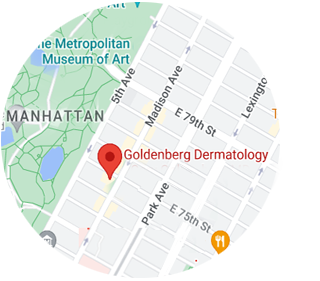
Introduction
Psoriasis is one of the most common skin diseases. Red, well defined spots that are covered with thick, silvery scales characterize the condition. These skin patches are dry, thick, itchy and sometimes even painful.
Psoriasis is uncomfortable and can make a person self-conscious because of its obvious and unpleasant appearance. While there is no cure, psoriasis can be successfully controlled with treatment and medications. Following is information about the types of psoriasis, the causes, and possible treatments at the Goldenberg Dermatology office in NYC.
Different Types of Psoriasis
Psoriasis is a chronic, inflammatory, autoimmune skin disease. The word psoriasis is derived from the Greek word “psora” meaning scale and refers to the red and silvery scales that are visible on the skin. Marked by periodic flare-ups and remissions, psoriasis can improve and worsen over the course of time.
Psoriasis is a genetic condition. Those with a family history of psoriasis are often predisposed to this skin condition. Psoriasis is not contagious. Skin disorders usually become visible for the first time 20-30 years old and 50-60 years old, however, psoriasis symptoms can show up at any age.
There are several forms of psoriasis, with the 5 main types being: Psoriasis Vulgaris (or plaque psoriasis), guttate psoriasis, inverse psoriasis, pustular psoriasis, and erythrodermic psoriasis. Though symptoms vary from individual to individual, the identifying characteristics of the different types are as follows:
Psoriasis Vulgaris
Psoriasis Vulgaris is the most common type of psoriasis and affects about 80-90% of people with psoriasis. Vulgaris is the terminology for “the most regular form”, but this type is also referred to as plaque psoriasis because of the presence of large plaques on the skin.
The identifying symptoms include areas of raised patches of dry skin and red lesions that are covered with silvery scales, which can be a singular spot or widespread. These patches or plaques most often show up on the scalp, knees, elbows and lower back, but can crop up anywhere on the body. A characteristic of Psoriasis Vulgaris is that the spots occur more or less symmetrically on the body. Furthermore, Psoriasis Vulgaris can cause significant discomfort, as the plaques are prone to inflammation, can crack and bleed, and are often itchy and painful.
Guttate Psoriasis
This type of psoriasis is also called eruptive psoriasis and primarily affects young adults. Guttate psoriasis is characterized by numerous small patches scattered over the body as droplets, especially in the area of the legs, arms, torso, and scalp. Immediate causes for guttate psoriasis are usually an upper respiratory tract infection, such as strep throat (caused by the Streptococcus bacteria) or the intake of antihypertensive drugs (beta-blockers).
Inverse Psoriasis
Smooth, red patches that typically appear in skin folds characterize inverse psoriasis. It is called inverse as it appears on the inner side, such as on the armpits, beneath the breasts, in the groin area, gluteal (buttocks) cleft, and around the genitals. Sometimes it is misinterpreted as a form of eczema or yeast infection. Many people that suffer from inverse psoriasis have another type of psoriasis elsewhere on the body as well.
Pustular Psoriasis
Pustular psoriasis is a less common form that presents as pus-filled bumps or blisters surrounded by red skin. This purulent exudate is commonly called pus and consists of white blood cells. In spite of its appearance and naming, pustular psoriasis is not an infection, nor is it contagious. Pustular psoriasis occurs most often on hands, fingertips or feet, but can also occur on any part of the body. Pustular psoriasis may follow, accompany or precede Psoriasis Vulgaris, plaque-type psoriasis.
Erythrodermic Psoriasis
The least common type of psoriasis is erythrodermic psoriasis. This type can develop on the entire body where a strong inflammatory reaction is accompanied by a massive dilation of blood vessels in the skin. Erythrodermic literally means “red skin”.
People with erythrodermic psoriasis experience a peeling, burning rash that can appear on the face, hands, feet, nails, torso, and extremities. The skin is red, tight, warm, swollen, scaly, and very itchy. A patient with erythrodermic psoriasis usually feels sick. This is a serious condition because the vasodilation causes the patient to lose a lot of fluids, proteins, and minerals. There is a risk of dehydration and acute kidney failure. A patient with erythrodermic psoriasis may need to be hospitalized and treated.
Other Types of Psoriasis
The five types of psoriasis described above are the most common types of psoriasis. Other so-called types of psoriasis usually refer to the location where the skin is affected, such as psoriasis capitis (on the head, scalp), psoriasis unguium (on the nails), psoriasis palmoplantar (on the hand palms), psoriasis arthropathic (on the small joints of the hands, fingers, and feet, also called psoriatic arthritis). During a consultation at Goldenberg Dermatology, in NYC, we can determine your type of psoriasis and advice the best possible treatment for your case.











